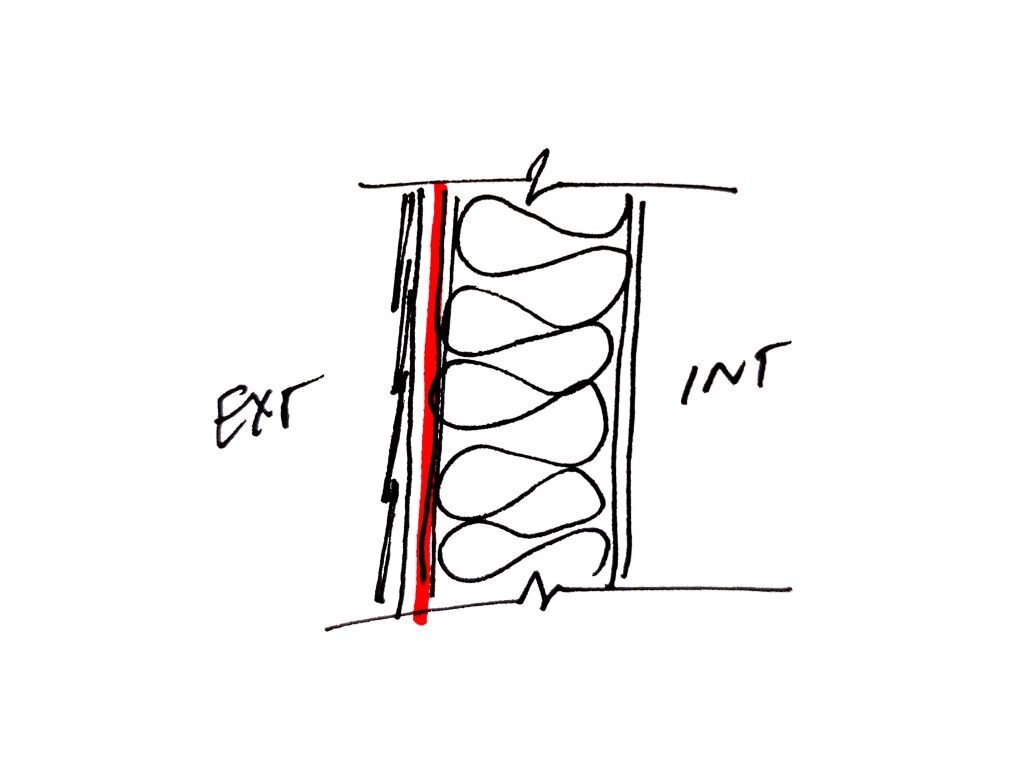Liked this article?
SIGN UP FOR THE BUILD IT BETTER EMAIL NEWSLETTER
Sign up nowLike your momma always said, there’s no such thing as a stupid question.
SIGA’s Etienne Gubler and Sean McStay had the pleasure of speaking with Dave Cooper and Mark Willie on the Dave Cooper Live Podcast to answer 10 common air barrier questions we hear all the time.
I’ve distilled the conversation down to 10 air barrier questions, but if you have the time, I recommend listening to the full episode below or on your favorite podcast app.
In short, yes there is a difference between your air and vapor barrier. An air barrier controls the movement of air through your wall assembly, while a vapor barrier controls the movement of water in your wall assembly in the form of vapor.
Fun fact: A vapor barrier can serve as an air barrier, but an air barrier does not necessarily act as a vapor barrier
Convection: Convection is the movement of a gas or liquid caused by temperature differences. The volumetric differences cause the hotter material to move toward the colder material.
Diffusion: Diffusion is the net movement of a substance from a region of higher concentration to a region of lower concentration. Diffusion is driven by a gradient in concentration.
There’s a massive difference between these two forms of moisture transfer and how much of an impact they’re going to have on your building assembly.
We want to prevent moisture from getting into our wall assembly because it will help our buildings last longer, make them healthier and (ideally) more energy efficient.
Diffusion is typically expressed with perm rating. That’s why we talk about the perm rating of different materials and the ability for the wall to dry based on that perm rating.
What we sometimes forget is that convection can transfer a tremendous amount more moisture than diffusion ever will.
An average family household produces roughly 220 gallons of water in form of vapor during a heating season through their daily activities like cooking, showering, washing.
In an airtight building with proper ventilation in place only about 24 ounces of that moisture will travel into the wall through diffusion.
In a typical not air-tight building, you have your traditional heating and cooling system, a large percentage of the produced moisture will be able to move into the wall through convection. That’s why air tightness is critical.
Diffusion is important and we need to calculate it, but if you get convection wrong you’ve got a waterfall in your wall instead of a cup.
Moisture problems are the number one reason for wall failures and callbacks. If you have a way to get rid of moisture problems, builders can save themselves a lot of time, money and headaches.

This is one of Sean’s favorite questions. If you take a sticky note and try and breathe through it, you won’t be able to. It’s acting as an air barrier. However, a sticky note is not very durable. When you’re evaluating air barrier materials, you’re looking for a durable air barrier.
There are lots of products out there that might get you airtight for your first blower door test, but aren’t designed for long-term air tightness. This isn’t a slight against that product, it was probably designed for waterproofing or something else first and people are now using it for airtightness.
Your air barrier could be your stucco, wood sheathing, WRB, vapor retarder, even paint.
You must ask yourself,
1) Is the product capable of being airtight?
2) Is the product designed to be an air barrier?
Products like spray foam might be airtight at first but are not designed for long-term airtightness.

Your air barrier can go in 3 different places:
>>> Read this article to learn the pros and cons of each air barrier location >>>
Where you put your air barrier depends on a number of factors, including things like installation know-how, cost, how prone to damage that layer is and your risk comfort, preferred material types and local building codes.
Like most things in life, it depends.
The quick answer is yes. Having two air barriers is a belt and suspenders approach. It’s great if you are looking for a really airtight build like Passive House.
What we need to watch out for is diffusion and permeability. If a wall assembly is airtight on the interior and exterior, and both of those air barriers use vapor closed products, you’re may have a problem. Any moisture in the wall assembly during construction is going to be trapped. You need to di a hygrothermal calculation to see how two air barriers will perform in your specific climate.
Your walls don’t need to breathe, they need to be able to dry. That’s a big difference.
You can’t control air quality if air can flow in and out of your building because it’s not airtight. Your ventilation system and filters are responsible for air quality.
Close those walls and make sure you use materials that are permeable if you’re in colder climates so if there is moisture in your wall assembly it can dry to the outside.
It all boils down to planning, product and performance.
Planning: Before construction, you want to be able to red line your building to ensure you can create a continuous air barrier. Every material transition needs to be accounted for, whether it’s the windows, top of the rafters and the roof assembly, you need to understand that transition and how you are going to keep that airtight layer.
Product: Evaluate what the products are designed for, what substrates and materials are they compatible with and what are the installation conditions. You could be planning your building during a nice, sunny and warm summer, but building in wet, snow or cold weather during the winter.
Performance: The team needs to understand how to use the selected products and how to get them to perform. Whichever manufacturer you pick should offer training for your crew or sub-contractors, whoever is going to be installing the product and working around it.
British Columbia has implemented Step Code, which is a progressive building code. Step Code is designed to gradually require better energy performance in our new buildings over the next 10 years. By the end everyone is going to be building at Step 5, which is almost Passive House levels of performance.
We’re going to be required to hit one air change at 50 pascals or less on our blower door tests. There’s a bunch of steps in between that to get people there. Some municipalities have decided to get their faster, but the overall message is make sure you are checking with your local building code to see what is required for air tightness.
Improve the air and weathertightness of your next building by signing up for our once a month email newsletter.

Added to my cart